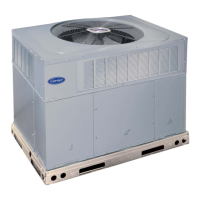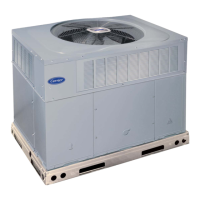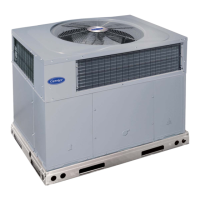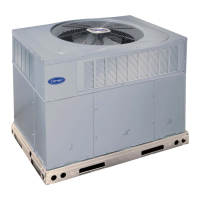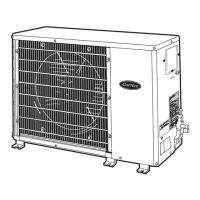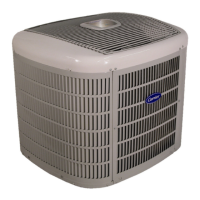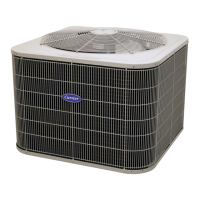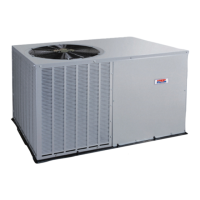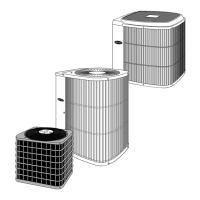50VR-K: Installation Instructions
Manufacturer reserves the right to change, at any time, specifications and designs without notice and without obligations.
29
with the proper electrical instrumentation. Refer to the unit wiring label
when making these checkouts.
NOTE: Refer to the heating and/or cooling sequence of operation in
this publication as an aid in determining proper control operation
Refrigerant Circuit
Inspect all refrigerant tubing connections and the unit base for oil
accumulations annually. Detecting oil generally indicates a refrigerant
leak.
This system uses Puron (R-410A) refrigerant which has higher operating
pressures than R-22 and other refrigerants. No other refrigerant may be
used in this system. Gauge set, hoses, and recovery system must be
designed to handle Puron (R-410A). If you are unsure, consult the
equipment manufacturer.
If oil is detected or if low cooling performance is suspected, leak-test all
refrigerant tubing using an electronic leak-detector, halide torch, or
liquid-soap solution. If a refrigerant leak is detected, refer to Check for
Refrigerant Leaks section.
If no refrigerant leaks are found and low cooling performance is
suspected, refer to Checking and Adjusting Refrigerant Charge section.
Evaporator Airflow
The heating and/or cooling air-flow does not require checking unless
improper performance is suspected. If a problem exists, be sure that all
supply- and return-air grilles are open and free from obstructions, and
that the air filter is clean. When necessary, refer to Indoor Airflow and
Airflow Adjustments section to check the system airflow.
Metering Device
This unit uses 2 types of metering devices. The outdoor metering device
is a fixed orifice and is contained in the brass hex-body in each liquid
line feeding the outdoor coils. The indoor metering device is a TXV type
device.
Pressure Switches
Pressure switches are protective devices wired into the control circuit
(low voltage). They shut off compressor if abnormally high or low
pressures are present in the refrigeration circuit. These pressure switches
are specifically designed to operate with Puron (R-410A) systems. R-22
pressure switches must not be used as replacements for the Puron
(R-410A)air conditioner.
Loss of Charge Switch
This switch is located on the liquid line and protects against low suction
pressures caused by such events as loss of charge, low
airflow across
indoor coil, dirty filters, etc. It opens on a pressure
drop at about 20 psig.
If system pressure is above this, switch
should be closed. To check
switch:
NOTE: Because these switches are attached to refrigeration system
under pressure, it is not advisable to remove this device for
troubleshooting unless you are reasonably certain that a problem exists.
If switch must be removed, remove and recover all system charge so that
pressure gauges read 0 psi (0 Pa). Never open system without breaking
vacuum with dry nitrogen.
High-Pressure Switch
The high-pressure switch is located in the discharge line and protects
against excessive condenser coil pressure. It opens at 650 psig (31.1
kPa). High pressure may be caused by a dirty condenser coil, failed fan
motor, or condenser air recirculation.
To check switch:
1. Turn off all power to unit.
2. Disconnect leads on switch.
3. Apply ohmmeter leads across switch. You should have continuity
on a good switch.
Copeland Scroll Compressor (Puron [R-410A]
Refrigerant)
The compressor used in this product is specifically designed to operate
with Puron (R-410A) refrigerant and cannot be interchanged.
The compressor is an electrical (as well as mechanical) device. Exercise
extreme caution when working near compressors. Power should be shut
off, if possible, for most troubleshooting techniques. Refrigerants
present additional safety hazards.
The scroll compressor pumps refrigerant throughout the system by the
interaction of a stationary and an orbiting scroll. The scroll compressor
has no dynamic suction or discharge valves, and it is more tolerant of
stresses caused by debris, liquid slugging, and flooded starts. The
compressor is equipped with a noise reducing shutdown device and an
internal pressure relief port. The pressure relief port is a safety device,
designed to protect against extreme high pressure. The relief port has an
operating range between 550 (26.3 kPa) and 625 (29.9 kPa) psig
differential pressure.
Refrigerant
This system uses Puron (R-410A) refrigerant which has higher operating
pressures than R-22 and other refrigerants. No other refrigerant may be
used in this system. Gage set, hoses, and recovery system must be
designed to handle Puron (R-410A). If you are unsure, consult the
equipment manufacturer. Failure to use Puron (R-410A) compatible
servicing equipment or replacement components may result in property
damage or injury.
Compressor Oil
The Copeland scroll compressor uses 3MAF POE oil. If additional oil is
needed, use Uniqema RL32-3MAF. If this oil is not available, use
Copeland Ultra 32 CC or Mobil Arctic EAL22 CC. This oil is extremely
hygroscopic, meaning it absorbs water readily. POE oils can absorb 15
times as much water as other oils designed for HCFC and CFC
refrigerants. Take all necessary precautions to avoid exposure of the oil
to the atmosphere.
CAUTION
!
EXPLOSION, SAFETY AND ENVIRONMENTAL
HAZARD
Failure to follow this warning could result in personal injury, death or
equipment damage.
WARNING
!
FIRE/EXPLOSION HAZARD
Failure to follow this warning could result in personal injury or death
and/or property damage.
Wear safety glasses and gloves when handling refrigerants. Keep
torches and other ignition sources away from refrigerants and oils.
CAUTION
!
EXPLOSION, ENVIRONMENTAL HAZARD
Failure to follow this warning could result in personal injury, death or
equipment damage.
This system uses Puron (R-410A) refrigerant which has higher
operating pressures than R-22 and other refrigerants. No other
refrigerant may be used in this system. Gauge set, hoses, and recovery
system must be designed to handle Puron (R-410A). If you are unsure,
consult the equipment manufacturer.
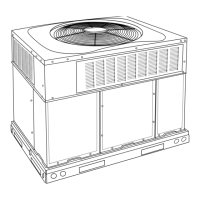
